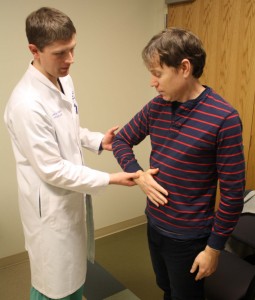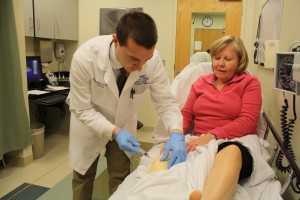
A resident physician conducts a physical examination on an SP. An SP can be given specific instructions on how to rate pain on movement or limit range of motion.
The Standardized Patient (SP) is a person who has been carefully coached to simulate an actual patient. Such individuals are used to “role play” case scenarios that are carefully designed by faculty to serve two potential goals: TEACHING and /or TESTING of clinical or related skills. Such educational activities may occur in a variety of settings where options exist to observe the encounter through one-way glass windows or to record the encounter on videotape for review purposes. Sometimes the SP may be a Standardized Participant, someone other than the patient including a parent or other family members, or another medical provider the learner must interact with.
The Standardized Patient Program at the College of Medicine of the Pennsylvania State University is part of the Clinical Simulation Center. It helps recruit and train candidates to become SP’s and also arranges reimbursement for their services. It helps faculty in case development as it relates to the use of SP’s and also serves as an institutional resource for any interested users.
Contents
The Standardized Patient

SPs can be combined with task trainers to create hybrid simulations. Here SP Eva Lynch shows concern as an orthopedic resident prepares to insert a needle into her “knee.”
SP’s may be lay persons or professional actors, each taught their new role of the specific case they are assigned. They may also be patients with known abnormalities where cases can be “built” around those abnormalities (e.g. known heart murmur).
Using a professional trainer and faculty help, SPs are coached to “mimic” cases, including “acting out” certain physical findings. They are also taught to provide constructive feedback to the trainee/examinee on the encounter. Such individuals are reimbursed at an hourly rate for their services.
Unique Benefits

An SP is attended to as part of an Ebola virus drill. The simulated patient was “admitted” to the ICU for a full 24 hours of patient care by providers dressed in appropriate protective gear.
The program provides a very useful and flexible teaching and testing tool. It is particularly helpful for the student in transitioning from the classroom to the care of real patients. To faculty, on the other hand, it provides a tool to both teach and test students in a consistent and standardized manner.
It can be used to provide a “controlled” exposure to situations that are difficult, sensitive or uncomfortable such as giving bad news, dealing with hostile or difficult patients or sexual/domestic abuse etc. Also, new trainees may get an opportunity to work with emergency conditions without the immediate concern for patient safety. Further, trainees get the opportunity to get direct feedback from the SP regarding their communication skills.
With inpatient hospital stays substantially reduced, it is particularly difficult to locate appropriate patients for training students. The selected use of SP’s overcomes this problem.
Who May Benefit?
- Medical Students
- PA Students
- Residents in training
- Physicians (faculty development, testing skills etc)
- Nurses and nursing students
- Other allied health professionals (pharmacy, physical therapy students, etc.)
